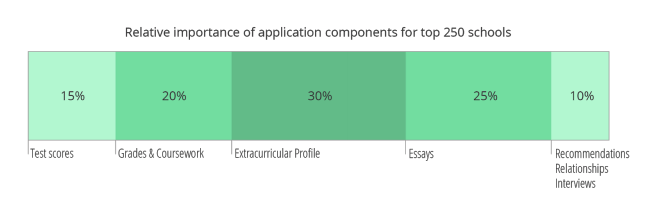Is Cornell Ivy League? Is Stanford Ivy League? Is MIT, Duke?
Our chancing engine factors in extracurricular activities, demographics, and other holistic details. We’ll let you know what your chances are at your dream schools — and how to improve your chances! Our chancing engine factors in extracurricular activities, demographics, and other holistic details. We’ll let you know what your chances are at your dream schools — and how to improve your chances! When it comes to college admissions, there is one group of schools that you hear about far more often than any others: The Ivy League. The renowned Ivy League is often regarded as the pinnacle of elite college admissions, with acceptance rates that regularly dip into the single digits. But Ivy League schools aren’t the only ones that attract top candidates and boast impressive admissions stats. For this reason, students may wonder if other, equally impressive schools are considered Ivy League. Are Cornell, Stanford, Duke, and MIT in the Ivy League? In this post, we’ll clear up the confusion regarding which schools are Ivies, and we’ll add in our top selective admissions tips, too. If you’re interested in applying to top schools, don’t miss this important post. While Stanford, Duke, and MIT have top-notch academics and selective admissions that rival that of the Ivy League, they are not actually Ivies. Cornell, however, is part of the Ivy League. Here’s a list of schools that are commonly mistaken for being in the Ivy League: These schools are likely thought to be in the Ivy League because of their prestige, highly-selective admissions, and quality academics, which the Ivy League is known for. There are also public universities that are sometimes mistakenly thought to be in the Ivy League, likely because there is the distinction “Public Ivy,” which simply refers to top public schools. These schools include: There are also liberal arts colleges sometimes thought to be in the Ivy League when they also aren’t. They include the following colleges, and are known as the “Little Ivies:” So what exactly is the Ivy League, then? The term Ivy League actually refers to a collegiate athletic conference composed of sports teams from eight private colleges in the northeastern United States. Though the term officially refers to an athletic conference, it is more commonly used to refer to these same eight schools in other contexts. The Ivy League was founded in 1954, the same year the NCAA Division I athletic conference was formed. At the time, the prestige associated with these schools was primarily due to the strength on the athletic field. Over time, though, the academic elite began to recognize these schools for their impressive resources and successful alumni. Now, admissions are so selective that it’s nearly impossible to think of the Ivy League without thinking of their synonymous academic selectivity. The eight schools in the Ivy League include: Here’s more about these schools: Brown University is located in Providence, RI and is widely recognized for the freedom it offers its students to create their own academic paths. Enrollment is around 7,000 and the acceptance rate is about 7%. Brown boasts an open curriculum, so outside of their majors, students are allowed to take whatever classes they would like. Brown was home to the first engineering program in the Ivy League, and computer science remains among its most popular majors. Columbia University is located in New York, NY and is known for its diverse campus and rich opportunities, which draw students from around the world. Undergraduate enrollment is just over 6,000, and acceptance rates recently dipped below 6%. Columbia’s setting in New York City is the ideal backdrop for its appreciation of diversity and culture. It hosts a School of General Studies specifically for nontraditional students, and while STEM fields remain very popular, social sciences and visual and performing arts are also among the most favored majors. Cornell University is the largest of the Ivy Leagues, located in Ithaca, NY and comprised of seven undergraduate colleges, each with its own unique and diverse identity and student body. Enrollment is just over 14,000 undergrads and acceptance rates for the class of 2023 were around 10%. Cornell’s size lends itself well to extensive and rich resources. It offers more than 4,000 classes and over 100 majors, though only 12% of classes have more than 50 students. Dartmouth College is the smallest of the Ivy League schools and is nestled in the rural town of Hanover, NH. It is a prestigious private research university that offers a liberal arts education. Enrollment is around 4,300 and acceptance rates for the class of 2023 fell below 8%. Dartmouth is well-known for its programs in business and engineering, and is highly regarded for the quality of its faculty and undergraduate teaching. Harvard University, located in Cambridge, MA, is probably the most well-known of the Ivy League schools, with the most selective acceptance rate of 4.5%. Undergraduate enrollment is just 6,700, but the campus also includes many graduate students swelling the student population to over 20,000. Harvard’s academics are highly regarded across the board, so it’s no surprise that its most popular majors include a breadth of nearly everything from social sciences and history to math, biology, and the physical sciences. Most recently, Harvard is making waves for its Making Caring Common initiative, which includes a goal of shifting the emphasis in college admissions away from academic achievement and towards things like service work and personal qualities. The University of Pennsylvania, or UPenn as it’s often referred to, is located in the heart of Philadelphia, PA and was the first university in the United States to offer both undergraduate and graduate studies. UPenn has an undergraduate enrollment of just over 10,000 and an acceptance rate around 8%. UPenn has a history of being a leading innovator in the field of education. It is one of the top research universities in the nation, and is home to the nation’s first medical school, first collegiate business school, and first student union. Princeton University, located in Princeton, NJ, currently holds the coveted #1 ranking in national universities from US News and World Report. Its undergraduate enrollment is around 5,400 and the acceptance rate for the class of 2023 was 5.8%. Princeton has a 5:1 student to faculty ratio and 73% of its classes have 20 or fewer students enrolled. It is most highly regarded for its programs in economics, public policy, and history. Yale University is located in New Haven, CT and has an undergraduate enrollment of around 5,400. Despite expanding acceptances in 2017 to offer two new residential colleges, Yale still has exceptionally competitive admissions with an acceptance rate for the class of 2022 of just 6.3%. Yale has a strong commitment to diversity, with admits to the class of 2022 representing all 50 states and 64 foreign countries. Yale’s financial aid awards in 2018 met 100% of demonstrated financial need, and 84% of the Yale College Class of 2017 graduated debt-free. The selective schools in this post have intimidatingly-low acceptance rates. You may be wondering how to improve your chances, and what these schools are looking for. Here’s our expert advice. Many top colleges use the Academic Index (AI) as a screening tool in admissions. The AI is a single numerical score calculated based on your GPA, class rank, and standardized test scores. Colleges will calculate each student’s AI, and those below a certain threshold may even get automatically rejected. (Note that those with special circumstances, like students from under-represented groups or those from low-income families, will likely have lower AI thresholds). Because the Ivy League gets tens of thousands of applications, using AI helps reduce the load of applications that need to be reviewed holistically. The key takeaway is that while amazing academics won’t get you automatically accepted, a below-average transcript could keep you out. To even have a shot of getting in, you’ll want solid grades and test scores within the middle 50% of the school you’re aiming for. Extracurriculars are just as important as academics at selective schools. This is because almost all applicants to top schools will have great grades, so extracurriculars are what help set students apart. Here’s a breakdown of the relative importance of your application components at top 250 schools: The extracurriculars that are most interesting and present a high level of achievement will have the most impact on admissions. To learn more about how extracurriculars are evaluated, see our post on the four tiers of extracurriculars. Essays are another way to set yourself apart from the competition. The best essays will not only showcase your strong writing skills, but also who you are as a person. In your essay, you should answer the questions: It’s also important for your essay to read like a story, and not like an analytical essay. You want the admissions officer to feel something when they read your writing and relate to your experiences. To learn more about writing a standout college essay, check out our guides for the 2020 Common App Essays and Coalition Application Essays. You can only improve your chances of getting in if you know what your chances are to begin with. We at CollegeVine have a data-driven chancing engine that lets you know your odds of acceptance at hundreds of schools, based on your academics, extracurriculars, and demographic info. You can also see how you stack up against other applicants, and which aspects of your profile you should improve to increase your chances. Sign up for your free CollegeVine account today and start using our chancing engine for free.

Your GPA and SAT don’t tell the full admissions story
Your GPA and SAT don’t tell the full admissions story
Are Cornell, Stanford, Duke, or MIT in the Ivy League?
Name of School
Location
Acceptance Rate (2019)
Middle 50% SAT
Middle 50% ACT
Stanford University
Palo Alto, CA
4.3%
1440-1550
32-35
University of Chicago
Chicago, IL
6.2%
1500-1560
33-35
California Institute of Technology (Caltech)
Pasadena, CA
6.4%
1530-1570
35-36
Massachusetts Institute of Technology (MIT)
Cambridge, MA
6.7%
1520-1580
34-36
Duke University
Durham, NC
7.8%
1500-1560
33-35
Rice University
Houston, TX
8.7%
1470-1560
33-35
Northwestern University
Evanston, IL
9.1%
1450-1540
33-35
Vanderbilt University
Nashville, TN
9.1% (2020)
1460-1560
33-35
Johns Hopkins University
Baltimore, MD
9.2%
1480-1550
33-35
Washington University in St. Louis
St. Louis, MO
14%
1480-1550
33-35
Notre Dame University
Notre Dame, IN
15.8%
1410-1540
33-35
What is the Ivy League?
Which Schools Are In the Ivy League?
School
Location
Acceptance Rate (2019)
Middle 50% SAT
Middle 50% ACT
Harvard University
Cambridge, MA
4.5%
1460-1580
33-35
Columbia University
New York, NY
5.3%
1480-1560
33-35
Princeton University
Princeton, NJ
5.8%
1460-1570
33-35
Yale University
New Haven, CT
6.1%
1470-1560
33-35
Brown University
Providence, RI
7.1%
1440-1550
32-35
University of Pennsylvania
Philadelphia, PA
7.7%
1460-1550
33-35
Dartmouth University
Hanover, NH
7.9%
1440-1560
32-35
Cornell University
Ithaca, NY
10.6%
1400-1560
32-25
Brown University
Columbia University
Cornell University
Dartmouth College
Harvard University
The University of Pennsylvania
Princeton University
Yale University
How Can I Get into the Ivy League School (or Ivy-Equivalent School)?
1. Achieve strong grades and test scores
2. Build a stellar extracurricular profile

3. Write Engaging Essays
4. Understand Your Chances






